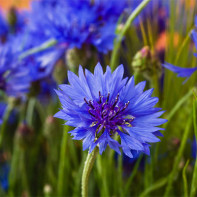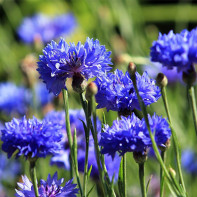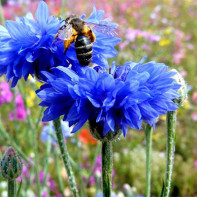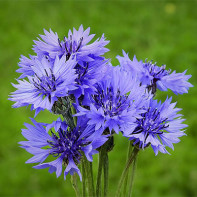Cornflower: medicinal properties and contraindications
It is difficult to imagine a summer field without a scattering of beautiful, blue flowers. They are called cornflowers. In our country, quite a few species grow. Almost any such interesting flower will look great in a bouquet. However, a blue or field cornflower is also used in medicine and cooking.
- Chemical composition
- How it looks and where it grows
- Kinds
- Collection and storage
- The healing properties of cornflower
- Cornflower in folk medicine
- For colds
- With hypertension
- For sight
- With nephritis, inflammation in the ureter
- With urolithiasis
- For the genitourinary system
- For problems with the liver and bile
- For the intestines
- With conjunctivitis
- Types of healing compounds
- Infusion
- Tincture
- Decoction
- Tea
- Butter
- Application in cosmetology
- Face lotion
- To narrow the pores on the face
- For problem skin
- Hair strengthening
- Cooking use
- Sauce
- Salad
- Vegetable side dish
- Borscht
- Contraindications
Since ancient times, marginal petals have been used in the conservation of products. Traditional Russian pickles cannot do without field cornflower. Flowers, leaves or stems are added to the composition of various seasonings, especially to meat dishes. They give a delicate aroma of cloves, mint and lemon, not enough pronounced, but easily perceptible.
In medicine, the marginal petals of the flower itself are used, without a basket. They are dried and prescribed for colds as a laxative and choleretic. They relieve the condition with jade and urethritis.
Chemical composition
The funnel-shaped marginal petals go to the blank. The best raw materials are bright blue. Baskets do not carry any useful properties and fall into the box only in the form of a weed component. By standards, 1% of substandard components are allowed - flower baskets, leaves, closed buds, earth, pebbles.
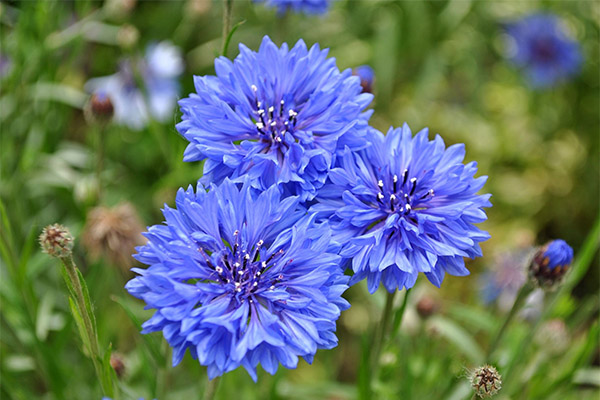
The composition is allocated only for the blue cornflower petals, they contain:
- tannins;
- active glycosides centaurin and chicorin;
- coloring glycoside cyanine;
- caffeic, quinic and chlorogenic acid;
- essential oils;
- vitamins A and C;
- trace elements: copper, selenium, zinc.
The most valuable for medical use are centaurin, chicorin and cyanine. They are responsible for the main medicinal capabilities of blue cornflower. By the way, it was found that flavonoids and glycosides are most found in flowers that grew in fields with oats.
How it looks and where it grows
Cornflower is easily distinguished on the field by a saturated blue flower. This is an annual plant with a slender stem. Height rarely exceeds 70 cm, the usual size for a field cornflower is 30–50 cm. The leaves are triple, weakly expressed, they die off at the time of flowering.
The flower has a shaped basket around which there are blue petals. In medicine, external leaflets are valued; they have a unique five-toothed shape. Active flowering window - June-July.
Blue cornflower grows throughout Russia and Europe, except for the Far North and arid regions. The plant prefers sandy soils. It can be found on any field of rye, oats or flax. It also grows well in meadows and steam fields.
Kinds
More than 500 species of cornflower are registered, of which 184 grow in Russia. Most of them have no special medical or culinary value. Farmers fight the flower like a weed in the fields. Ruminants can eat it without any consequences.
Among the species widespread in Russia, one should single out rough and meadow - they are excellent honey plants, and are limitedly used in folk medicine. The most valuable cornflower blue or field. It is used in cooking, cooking for the winter and is included in various medical fees.
Other common types of cornflowers are of decorative value only, can be used as honey plants or go to feed ruminants.
Collection and storage
For medical purposes, only bright blue cornflower petals are used.They are plucked from funnel-shaped flowers, which are in the active stage of flowering. The best time is June-July, occasionally the beginning of August. Then the content of nutrients in the petals goes into decline. Cornflower seeds also appreciate cooking, they are harvested closer to mid-August.
There are several collection technologies. Ancient - more sparing for the plant. Hands cut off only the extreme, most beautiful and bright blue leaves. The flower itself does not damage. New industrial technology prescribes to pick or cut flower baskets, and then blue petals should be allocated from them, and white corollas should be thrown away. Raw materials collected using this technology are sold in pharmacies as fees and teas of field cornflower.
Drying of the torn petals is carried out at a temperature of 40-50 degrees. Beneficial glycosides may begin to degrade under the influence of prolonged dry heat. Today, artificial dryers are widely used. However, you can use the old proven method, laying out the raw materials on paper with a thin layer in a well-ventilated room.
Dried cornflowers are stored up to a year. However, it is necessary to keep the raw materials in a dark place, as the sunlight will lead to the decay of cyanine and other active substances. This can be determined visually - spoiled dried petals turn white.
The healing properties of cornflower
- Decoctions and infusions on the flowers of cornflower have a pronounced choleretic and antispasmodic effect. They improve the activity of the gastrointestinal tract, have a mild laxative effect. A diuretic and stimulating kidney function was noted.
- Brevicepsin in the composition dilates blood vessels and normalizes slightly elevated pressure. Due to the removal of the spasm of smooth muscles, a moderate analgesic effect is noted.
- The anti-inflammatory and disinfecting capabilities of blue cornflower are actively used by doctors and traditional healers. Lotions, dressings, compresses on wounds, inflammations, bruises or ulcers are used. It is allowed to include in complex therapy to combat conjunctivitis and blepharitis as an alternative to other symptomatic drugs.
Cornflower in folk medicine
From ancient times, healers included cornflower flowers in various potions and health-improving preparations.
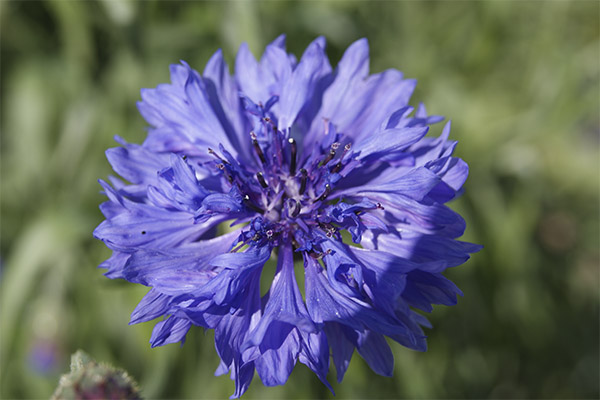
For colds
A good vitamin composition, strong active ingredients can accelerate the cure for flu, colds, bronchitis and significantly alleviate the general condition. It is recommended to take the following components:
- dry cornflower - 20 g;
- honey - 15 g;
- water - 250 ml.
Dry product must be filled with 250 ml of boiling water. Leave to insist for 30-40 minutes. Filter, put a spoonful of honey and drink all the liquid 20 minutes before eating. This will give strength to the body to fight the disease, facilitate the course of the disease.
With hypertension
With hypertension, the most effective herbal collection, including such components:
- dry yarrow - 10 g;
- Valerian root - 15 g;
- white mistletoe - 10 g;
- dry rowan berries - 20 g;
- dried flowers of cornflower - 15 g;
- Hawthorn fruit - 10 g.
The mixture of herbs and fruits must be crushed and mixed, you can use a blender. Pour the finished collection into a container, and then take 1 tablespoon per glass of boiling water. Insist 20-30 minutes, strain before use. A glass is enough for 3 doses, 70–80 ml, immediately after a meal.
For sight
This collection will help improve vision with myopia. It will be required:
- incised aloe leaves - 20 g;
- eyebright grass - 50 g;
- cornflower flowers - 50 g;
- honey - 600 g;
- red wine - 500 ml.
Fresh aloe leaves should release excess juice, so you need to cut them and leave for 15-20 minutes. The eyebright grass, cornflower flowers and aloe leaves washed from excess juice should be placed in a blender or coffee grinder, chopped until smooth. Now you need to build a water bath, put honey, red wine and herbs in a container. Steam for about 50 minutes, maintaining the temperature at 60–70 degrees. Having passed, you can start taking. The optimal dosage is 1 tablespoon three times a day.
With nephritis, inflammation in the ureter
It is necessary to prepare such a phytotherapeutic drug:
- bearberry leaves - 15 g;
- juniper branches - 20 g;
- field cornflower petals - 15 g.
Mix the ingredients into a single mass and scoop 1 dessert spoon with a small slide. So you can get the necessary proportions based on 250 ml of liquid. Insist composition for 15 minutes, pour boiling water over boiling water. Filter using a sieve or folded gauze. Take three tablespoons 1 tablespoon.
With urolithiasis
To get rid of urolithiasis will help such a drug collection:
- blue cornflower flowers - 15 g;
- fresh nettle - 10 g;
- leaf from a walnut tree - 15 g;
- calendula - 15 g;
- dry veronica - 15 g;
- three-colored violet - 25 g.
Raw materials must be thoroughly mixed. Pour 1000 ml of hot water, but not boiling water. Leave to cool for 5-6 hours. You can strengthen the infusion simply by wrapping the container in towels or a blanket. Then place the container on the stove and keep on the verge of boiling. 10 minutes is enough. Drink every 4 hours, but not more than 5 times a day, 1 tablespoon.
For the genitourinary system
Various problems with urination will be delicately solved by an infusion made according to this recipe:
- lingonberry leaf - 1 tablespoon;
- field cornflower flowers - 1 tablespoon;
- boiling water - 500 ml.
Herbs must be poured with boiling water and insisted under a lid. Enough 40 minutes, but you can wait a little longer, this will increase the concentration and effect. After straining, take in small portions of 50–70 ml. All infusion should be consumed per day. The positive effect is felt after the third dose. The therapeutic course - no more than a week.
For problems with the liver and bile
The following tincture is used:
- blue cornflower flowers - 20 g;
- good vodka - 300 ml.
A dry plant must be placed in a container with vodka and shaken thoroughly. Insist in a dark, slightly cool place. It is critical to protect the cornflower from direct sunlight. After 10 days, you can take the drug. The optimal dosage is 30 drops before meals, three times a day.
For the intestines
Various intestinal motility problems and chronic constipation can be treated with a cornflower. This will require:
- dry flowers - 25 g;
- cool boiling water - 250 ml.
Dry cornflower should be poured with boiling water, mix and cover tightly. Insist up to two hours. Then use only before meals 30 ml. If you need a mild effect and correction, it is enough to take the infusion twice a day. An increase in the number of doses with the same dosage will enhance the laxative effect.
With conjunctivitis
Such a collection will help to quickly cure conjunctivitis:
- rosehip flowers - 10 g;
- chamomile - 10 g;
- plantain leaves - 10 g;
- blue cornflower flowers - 10 g.
All medicinal plants must be mixed and pour 250 ml of boiling water. Insist under a tight lid for half an hour. Filter the cooled infusion using cotton wool or gauze, and then drip 2 drops daily. Keep the drug in the refrigerator, but it is important that the substance is at room temperature before instillation.
Types of healing compounds
Cornflower field goes well with a water, alcohol and fat base. It is included in various herbs, where it enhances their healing effect. Active substances are released into water at temperatures above 50 degrees. Boiling is well tolerated, only some vitamins and a small part of glycosides are lost.

Infusion
The water base effectively retains the active substances from the flowers of the cornflower. The concentration distinguishes infusion for external and internal use. A classic potion that strengthens the body, helps to quickly overcome a cold, includes:
- dried flowers of blue cornflower - 3 teaspoons;
- boiling water - 1 liter.
Medicinal herbs pour boiling water. Mix thoroughly and cover the container. The optimal period of infusion is 30 minutes. When adding other herbs or berries, it may take longer to release the beneficial substances into the water.
Infusion for external use has a different concentration:
- field cornflower - 1 tablespoon;
- boiling water - 250 ml.
It is prepared in the same way, with the exception of the insisting time, up to an hour.It is advisable to wrap the container in a towel or cloth in order to keep the heat longer.
Tincture
An alcohol-based form will require up to two weeks of time, but then the tincture can be stored for a year, it will remain effective and healing. For cooking you will need:
- dry cornflower flowers - 50 g;
- good vodka - 500 ml.
The optimal ratio of base and therapeutic agent is 10 to 1. The flowers of the cornflower are placed in a bottle with vodka and shaken. But it is better to use a darkened container. Under the sun, these petals lose their beneficial properties. Insist in a dark, cool place for at least two weeks. Store for a year.
Decoction
Traditional broth is especially effective in the treatment of bronchitis, tonsillitis, it is used as an expectorant. Also used in the form of drops and lotions to get rid of blepharitis and conjunctivitis. In the preparation involved:
- marginal cornflower petals - 1 teaspoon;
- water - 250 ml;
- honey - 30 g.
Add dry petals to water and bring to a boil over a fire. Boil for 2-3 minutes. Boil a more concentrated preparation for external use for 5 minutes. Then remove from heat and leave at room temperature for an hour. The cooled broth, which is intended as an expectorant or to combat sore throat, must be flavored with honey.
Tea
This is the most simple and affordable form of cornflower. In pharmacies you can find the fees already packaged in bags, they should be brewed like regular tea. Self-preparation will require the following components:
- dried cornflower flowers - 2 teaspoons;
- green tea - 1 teaspoon with a slide;
- boiling water - 500 ml.
In the container, you need to lay tea and cornflower flowers, and then pour boiling water. With the lid closed, brewing takes 5 minutes. Before serving, add a spoonful of honey or sugar for a better taste.
Butter
For medical purposes, oil is not used, only in cosmetology. It smoothes the skin, especially in the eye area, nourishes it with useful substances, prolongs youth, improves the tone of the subcutaneous layers. To prepare a classic recipe you will need:
- dry petals of a cornflower field - 1 tablespoon;
- olive oil - 60 ml;
- Vitamin E - 3 drops.
It is necessary to grind dry cornflower petals in a mortar or blender. Then gradually pour the olive oil, stirring the mixture, lastly add a few drops of vitamin E. You can apply immediately, applying in the form of a mask or compresses on the face.
Application in cosmetology
Many face care products and various cosmetics contain an extract from the flowers of a blue cornflower. It can be found in tonics, gels, makeup removers, shampoos and conditioners. Commercial companies value this component for versatility and affordability.
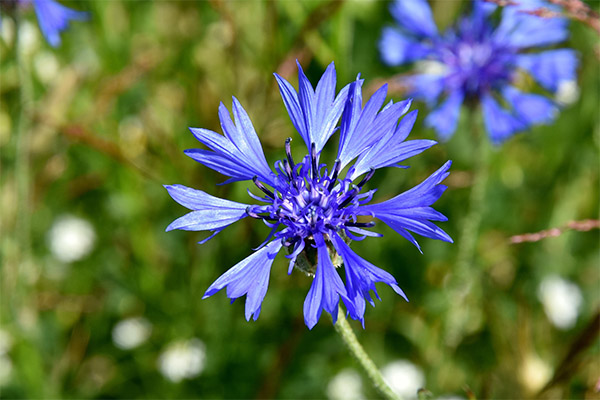
The active substances in the cornflower have a pronounced anti-inflammatory effect. They heal wounds, help get rid of acne and acne on the face or body. Cornflower is especially useful for people with oily skin. Even a small addition to the composition allows you to clean and then narrow the pores, align the subcutaneous structure. A matting effect is created, it persists for a rather long time.
The use of cornflower petals in care products visually improves the health of the hair. When rubbing, the roots are strengthened, the skin is better cleansed and saturated with useful substances, which is the prevention of dandruff. There was an increase in hair growth when adding cornflower extracts to daily shampoo.
Face lotion
Cornflower can be used at home, the recipes are quite simple, and the ingredients are affordable and inexpensive. In creating a universal face lotion involved:
- dried flowers of cornflower - 30 g;
- lemon juice - 1 tablespoon;
- hot green tea - 400 ml.
It is optimal to use tea brewed for 5-7 minutes. Add cornflower flowers to it, close the container until it cools down to the level of body temperature. Before the procedure, pour lemon juice into the lotion and mix. For oily skin, you can add alcohol, regular vodka - 100 ml.
To narrow the pores on the face
It is easy to prepare a simple broth to narrow the pores on the face. This will require:
- field cornflower flowers - 2 teaspoons;
- water - 500 ml.
Add the medicinal plant to water, cover and boil for 10 minutes. Then allow to cool at room temperature and filter. Apply with a swab or use an old daily mask, dampening it from the inside.
For problem skin
People with problem skin prone to inflammation should use this infusion:
- a series of dry - 10 g;
- pharmacy chamomile - 10 g;
- calendula - 10 g;
- cornflower - 10 g;
- boiling water - 200 ml.
Mix and pour all the ingredients with hot water, leave for 24 hours while maintaining the temperature. A thermos is best for this. However, you can wrap any capacity, slightly warming it 2-3 times a day. It is better to apply in the form of a mask, for this, take 1 tablespoon of the resulting infusion and add it to a viscous mixture of olive oil and honey. The optimum exposure time is 20 minutes.
Hair strengthening
A cornflower is also useful for hair. For an effective root strengthening tool you will need:
- field cornflower flowers - 1 tablespoon;
- food vinegar 9% - 250 ml;
- water - 250 ml.
Vinegar, water and a medicinal plant must be mixed, and then left to infuse at room temperature. The product will be ready in half an hour, and you can store it in the refrigerator for up to two weeks. To strengthen the roots, it is necessary to rub the infusion 2 times a day, and before going to bed, be sure to rinse your head with plain water.
Cooking use
In addition to pronounced medicinal properties, cornflower has been widely used in traditional cuisine. The flowers and seeds of the plant are used, they are dried and crushed. A seasoning in the form of a powder can sometimes be seen in supermarkets, often a cornflower is a part of various mixes for pickles, soups or meat.
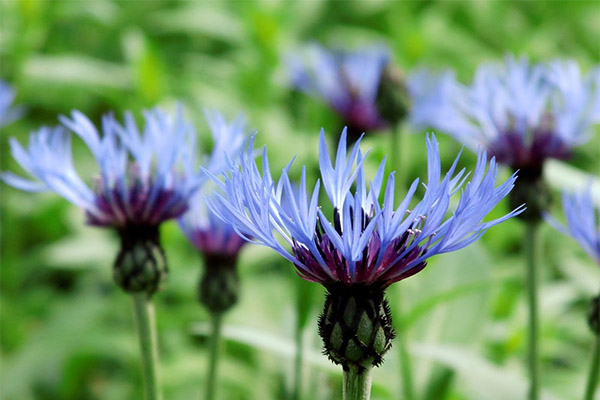
Billets can be varied well with petals and cornflower seed powder. They give a subtle mint-lemon flavor, improve the safety of pickles. The recipe is extremely simple, you should add 10-15 g of powder and 2 teaspoons of petals to a three-liter jar of canned vegetables.
Cornflower leaves have a delicate but expressive taste, a cross between lemon, mint and cloves. Sunflower seeds are a bit like red chili peppers, but with a light mint flavor. This combination is well suited to a universal sauce for rice, mashed potatoes and meat dishes.
Sauce
For cooking, you need such products:
- beef or chicken broth - 2 tablespoons;
- grated tomatoes - 1 tablespoon;
- butter - 15 g;
- dried cornflower flowers - 1 teaspoon.
It is better to use a natural broth, but can be made from a cube. This applies to tomatoes, if not fresh, then it is permissible to take canned boiled cans. All ingredients must be warmed up in a container and mixed until smooth. If the sauce is made with meat, it’s good to add a little rosemary.
Salad
Energizing spring salad with strength and strength - it also cannot do without a cornflower. To prepare it you need:
- fresh dandelion leaves - 50 g;
- fresh dill - 10 g;
- rabbit cabbage - 50 g;
- borago or cucumber grass - 100 g;
- sour cream 20% fat - 25 g;
- field cornflower seed powder - 10 g.
Soak the leaves in a bowl with water and leave for 15-20 minutes. Then let the liquid drain and finely chop. Mix in a dish or bowl, add cornflower seed powder and sour cream. To taste, use other seasonings and salt. Green onions or early radishes are good for salad. But these are not the required ingredients of the dish.
Vegetable side dish
A healthy vegetable side dish can be cooked quickly. The following components will be required:
- beets - 250 g;
- flour - 50 g;
- vegetable oil - 30 g;
- dried cornflower flowers - 10 g;
- citric acid - 2-3 g;
- salt, pepper and other seasonings - optional.
Beets must be boiled until cooked, directly in the peel, as is done for salads. Then peel the cooled vegetable and grind it on a coarse grater. In a pan, pour half the vegetable oil prepared for the recipe and fry the flour until golden. Now add the grated beets, cornflower flowers, citric acid, spices, about 100 ml of water and the remainder of the oil. Stew under the lid over low heat for 10-15 minutes.
Borscht
You can also cook unusual borscht, very tasty and healthy. Would need:
- meat broth - 500 ml;
- white cabbage - 100 g;
- onion - 1 pc.;
- beets - 50 g;
- potatoes - 2 pcs.;
- carrot - 1 pc.;
- boiled egg - 1 pc.;
- classic tomato sauce - 1 tablespoon;
- sour cream 20% fat - 25 g;
- dried petals of blue cornflower - 15 g;
- spices, herbs - optional.
Borsch is cooked in a classic way, according to your favorite recipe. The differences begin at the final stage of preparation. Part of the onion must be passivated and left, like tomato paste. Add them 10 minutes before readiness, along with cornflower and spices. If greens are used, then they should be laid after another 5 minutes. Already on serving, add sour cream and a sliced boiled egg to the plate. Such borscht comes out extremely tasty and healthy.
Contraindications
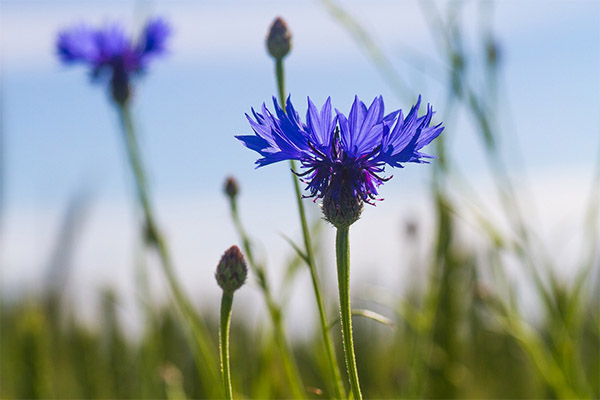
- Special substances - coumarins - in the body interact with prothrombin, so blood coagulation is inhibited. Cornflower cannot be taken in any form with active bleeding. This applies even to wounds and cuts, first you need to stop the blood, and only then, after standing for 2-3 hours, you can apply medicinal compresses.
- During pregnancy and lactation, it is not recommended to take any drugs that include field cornflower. It has specific toxicity for the fetus and children under two years of age. The danger of a systematic or single peak intake of the active substances of the plant to the fetus or child with mother's milk is proved.
- Cornflower glycosides and essential oils are quite active and can react with many drugs. Therefore, for the period of drug therapy, it is better to interrupt the intake of decoctions or infusions.
- Patients with diagnosed gallstones should refrain from taking cornflower. A moderate choleretic property can lead to obstruction of the ducts and the need for urgent surgery.
- The peak rate of systematic reception of cornflower is 30 days. Then you need to pause at 2 weeks. Otherwise, the manifestation of side effects, nausea, liver disorders is possible.
«Important: all information on the site is provided exclusively in fact-finding purposes. Before applying any recommendations, consult with a profile specialist. Neither the editors nor the authors are liable for any possible harm caused materials. "

